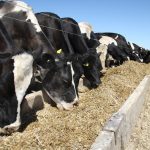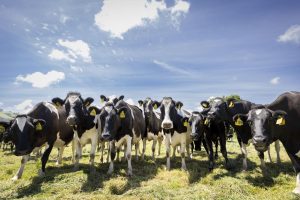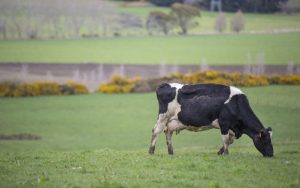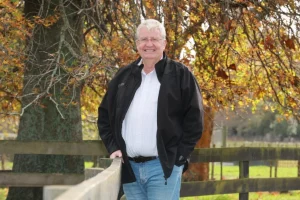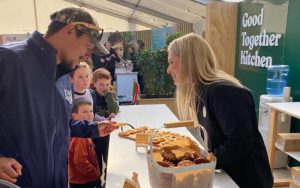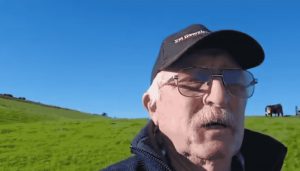
Dairy accounts for about 21% of the company’s Scope 3 greenhouse gas emissions and is Nestlé’s largest single source.
Dairy will continue to play a crucial role for food giant Nestlé, but the company wants to see a reduction in on-farm emissions by 2030.
Florence Henry, Nestlé’s global head of sustainability for nutrition, said given the need for nutritious food to feed a growing population, dairy will continue to play a crucial role, but she wants farmers to continue making progress improving their sustainability.
The market is telling them the future is low-carbon milk.
“We have a big responsibility to feed a growing population,” she told Farmers Weekly.
The three sustainability priorities for all its suppliers are improved productivity, climate and regenerative agriculture.
For farmers, regenerative agriculture means sustainably managing or restoring soil and water and biodiversity quality.
Henry said in a video conference that she accepts New Zealand farmers work with and care for nature, saying that is part of their DNA.
But sustainability makes sound business sense and Nestlé is reflecting what its consumers are telling them and what is increasingly becoming a requirement of government regulators such as the European Union.
“Consumers want to hear stories about where their food comes from, how it is made, how natural it is and how respectful it is of nature, the environment and animal welfare.
“The more you tell the story the more it resonates with and connects to consumers.”
Last month, Speaking via Zoom from Switzerland at the New Zealand Institute of Primary Industry Management conference at Mystery Creek, Nestlé global procurement category lead for dairy Bruno Spire challenged the claim that New Zealand dairy farms have the lowest global carbon footprint.
He said “New Zealand has low emissions but not the lowest.”
Dairy accounts for about 21% of the company’s Scope 3 greenhouse gas emissions and is Nestlé’s largest single source.
Methane is responsible for 40% of total emissions from its dairy operations.
Nestlé wants to see farmers making continuous improvement on sustainability issues and it is prepared to help.
“We’re on the side of farmers,” Henry said.
She said farmers are at the centre of its sustainability efforts as they manage resources and make decisions on practices that suit their individual circumstances.

NZ dairy farmers cannot afford to relax, even though “you are starting from a very strong base if you consider emissions at a farm level”.
She said the NZ dairy industry is well aware of the need to continue improving.
“There is a lot of very positive forces such as DairyNZ and Fonterra co-operative embracing the agenda and really wanting to advance.
“NZ is well positioned but there needs to be continuous improvement.”
According to its 2023 annual report, Nestlé is more than halfway to achieving its 2025 goal of reducing absolute greenhouse gas emissions and well on the way to its 2030 goal of 50% reductions.
About 80% of those reductions are being achieved by changes in the way it sources raw materials, such as investment in deforestation prevention and regenerative agriculture.
Dairy is Nestlé’s single largest raw material, sourced from 200,000 dairy farmers in 27 countries. With such a diverse supply base, Henry said, farmers in different countries have different levers to pull.
Farmers are not on their own, with Nestlé offering incentives to help farmers transition, helping them adjust and investing in research.
Nestlé has its own dairy climate plan but is also part of the Dairy Methane Action Alliance, an international industry body charged with tackling the issue.
Through its action plan, Nestlé is working with Fonterra suppliers on projects such as planting native trees on marginal farmland for carbon capture, reducing on-farm greenhouse emissions through nutrient and fertiliser management, and demonstrating approaches to achieve net zero emissions while retaining farm profitability.
Similarly, it is partnering with Synlait in a seven-year programme.
This includes wastewater management systems, low-carbon emissions feed options, advanced soil testing, alternative fertilisers and tree planting.
The Nestlé Institute of Agricultural Sciences is researching dairy emission reduction techniques including methane-reducing feed supplements, manure management and improved diets.
In 2023 Nestlé developed and implemented a new approach to collect dairy emissions data and measure impacts in markets around the world so it can help suppliers adopt new ways to reduce emissions.
Nestlé has also established a dedicated team to work with its largest dairy derivatives suppliers with work focused on improving diets to reduce dairy emissions.
Nestlé last year had NZ$179 billion in sales, which included milk products and ice cream contributing $21bn, confectionery $15bn, powder and liquid beverages $24.8bn and nutrition and health science $29.4bn.
According to its annual report, Nestlé sells into 188 countries, with more than half its sales in Europe and North America. It employs 270,000 people.
More: Wallace is visiting seven countries in six weeks to report on market sentiment, a trip made possible with grants from Fonterra, Silver Fern Farms, Alliance, Beef + Lamb NZ, NZ Meat Industry Association and Rabobank. Read more about his findings here.
You can now read the most important #news on #eDairyNews #Whatsapp channels!!!
🇺🇸 eDairy News INGLÊS: https://whatsapp.com/channel/0029VaKsjzGDTkJyIN6hcP1K

